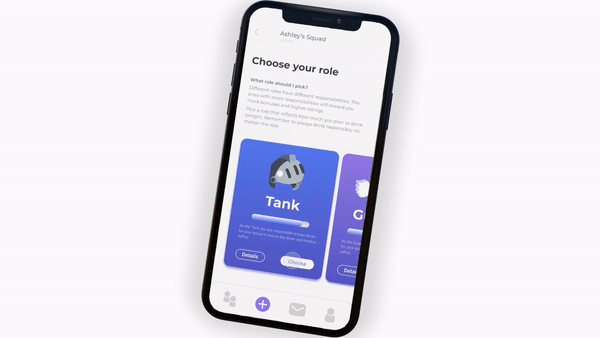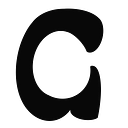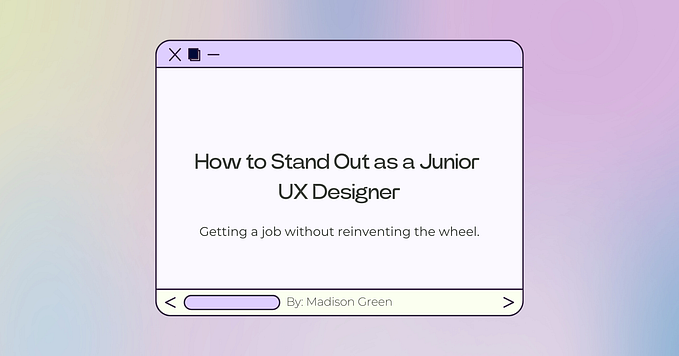3 secrets to help you become a UX Design intern at Apple, Google, or Amazon in 2023

Finding an internship is hard, and finding one at a big tech company like Amazon, Google, or Apple is even harder.
I listed these three companies as an example since I have received offers or final round interviews with them in my past between 2016–2018.
Sure a lot has changed after Covid, but a lot has stayed the same in 2023.
Many design students find recruiting to be extremely stressful at times, which was how I felt back in the day. Therefore, I wanted to share with you some advice that I have gained over the years.
Before we begin, a few disclaimers of what this article is NOT about.
This article is NOT meant to limit your career path.
Being a student is great because your potential is endless. Interning at a company like Amazon surely sounds exciting, but don’t limit your future career path by telling yourself that this is the only way to “success”.
This article is NOT about how to prepare for a specific company hiring/interview process.
I am humbled to have had final round interviews with 9 amazing companies this year. From portfolio presentations to whiteboarding challenges, sharing my work during an interview is fun. In the future, I would love to share details on how to prepare case studies for each company specifically, but this article is not about that.
This article is NOT meant to give you suggestions for your resume or portfolio.
The goal of today’s writing is to offer holistic advice on how to best use your time in and outside of school, to prepare yourself and maximize your chances of being hired by these big tech companies.
Still with me?
Good, here are the 3 most important “secrets” that I want to share with you today to help you succeed.
1. Be critical and identify your knowledge gaps.
Did you know the U in UX design stands for “unicorn”? Okay, not really. But similar to a unicorn, a UX designer must have a mix of diverse skills and traits that they can bring to the table. From my experience, I have found that school alone does not adequately prepare us as UX designers with the skills required to obtain one of these coveted jobs. I often refer to these additional necessary skills as “knowledge gaps.” It is crucial for you, as a student, to reflect on yourself and your current field of study to identify your potential knowledge gaps.
In my opinion, as a student applying for a UX internship at big tech, you need to fill these six areas of knowledge.
Presentation
Visual design
Basic front end coding
Design tools such as Figma, Sketch, and Adobe
Design thinking and the design process
User research and data analysis
I’ve found that no university or program covers all of these topics. None. This holds for even the newest and best design programs. To illustrate my point, I will compare and contrast two of the University of Washington’s highly competitive and awesome design programs: Interaction Design(IxD) and Human-Centered Design and Engineering (HCDE). As a third-year in the IxD program, I have covered the fundamentals of UX design including “goal-directed design approach” and how to create design systems and interfaces. We are repeatedly drilled through all the details of visual design techniques and are pushed to create pixel-perfect designs. However, the IxD program does not teach any front-end coding skills. The HCDE department offers extremely similar design courses with more emphasis on user research and front-end coding, such as a wide selection of coding classes from Python to React.
From these two examples, you can see that there are clear “knowledge gaps” within each program. Understanding basic front-end development and visual design are both equally important for someone who wishes to intern in big tech. Therefore, no matter which program you are enrolled in, you need to use your own time to fill those knowledge gaps.

There are many great resources out there to help you. For example, I have taken over 50 hours of free coding courses on Coursera to fill my knowledge gap on web development. Was the coding knowledge immediately useful at an interview? No, definitely not. But it helped me identify certain design proposals that could result in push back to work better with developers, a question asked by one of the designers at Amazon during my interview.
This is also why you will find that many senior and principal UX designers come from diverse backgrounds ranging from arts, engineering to even marketing. What makes someone a successful UX designer is not about which program you majored in, but about if you filled your existing knowledge gaps.
To learn more about university programs, knowledge gaps, and how to be critical, view my podcast episode here.
2. Be willing to work for free, A LOT.
Building upon the concept of “knowledge gaps,” there is one area that cannot be filled on your own or through school, and that is work experience.
Here is your easy solution: be willing to work for FREE.
Oh did I say willing, I meant eager. Be eager to work for FREE.
If I am good at something, why should I work for free?
Anyone can throw a few good mock-ups on a website and call it a portfolio, so without work experience, how is your resume even going to get past the recruiter and not go straight into the trash? Paid work takes time. Recently, I was offered a pay scale of around $50 an hour to do contract UI/UX work. Many would say this is a pretty good deal for someone still in school. However, I spent almost three years working multiple part-time UX jobs for free before I got to this point. A lot of these roles were challenging and frustrating for a variety of reasons, your labor could even feel exploited to a certain degree. Just remember, your compensation is experience, not money.
My first design job was as an interactive exhibit design intern in Beijing, China. The firm was well known for working with large clients including Amazon, Nio, OnePlus, and Mercedes-Benz. I sharpened my Photoshop graphic design, Cinema 4D modeling, and presentation skills there. So what’s the catch? For starters, I had to spend over 80 minutes commuting to the company every day. I got to the office at 8:00 am and got off at 5:30 pm. Not to mention I was paid a hundred yen a day which equates to slightly more than one hour of minimum wage here in Seattle. I also worked almost every weekend for free. However, I am grateful for this job, because I experienced what it is like to work at a real design firm. I pitched my bid proposals to big clients at board meetings, and my design skills were pushed to their limits with fast deadlines in high-pressure environments. These skills are all common expectations at big tech companies.

Is it fair for big tech companies to expect internships or work experience?
Yes, it is fair. Not only does work experience show others you understand the basics of teamwork, but it also proves that you understand the differences between the industry and school. And oh boy, industry sure is different from school. If you have never worked a real design job before, then let me paint you a picture. Even in the most design-driven companies out there such as Apple, you will spend the majority of your time in meetings.
Why? Because design needs teamwork and communication. There are always different perspectives to consider, from business requirements, conversion metrics, push backs, to a million different things. In school, we often observe design from a vacuum without bounds or limitations. Work experience helps you shift away from this perspective by teaching you to work with constraints beyond our scope as designers. When UX design is done in a vacuum, speaking frankly, people will call it bad design.
So please, put yourself out there and work for free. The job does not even have to be strictly UX design-focused: I have worked countless hours freelancing motion graphics and directing marketing videos. I spent hours learning tools like Premiere Pro and After Effects. During one of my four-hour interviews with a UX/UI team with Apple this year, I was asked multiple times to elaborate on specific motion design prototypes I created using After Effects. Once again, time spent learning as a design student is never wasted. Be willing to put yourself out there and work hard.

3. Be humble and trust the process.
Although I have reached a point in my work and academic life where I feel confident in sharing advice with other students. I am always excited to grow and learn from other designers. That is why we should be humble. Too many new designers fall short in this area, they are very talented, yet with their first taste of success, they believe they are “better” than others.
Once you stop learning, someone will excel over you eventually. Besides, how can you quantify “better,”? Is it because of your school? Your job title? Your salary?
Confidence from comparison is a slippery slope.
Even the most experienced designers and mentors will tell you that there is a lot of luck involved in job opportunities. You should be excited to intern somewhere to learn and grow, not because it “elevates” your status. So make sure you are working hard for the right reason.
Many years ago, because of my specialty in VR, I interviewed with two teams from Google to join as a new grad UX designer. I was so excited for this opportunity. Unfortunately, all UX roles at Google were canceled that year due to Covid-19.
A few years later, I had another opportunity to take on another mid-level to a senior role at Google but I had a medical emergency, removing my lower left lung, which I ended up barely surviving, staying in the hospital for 3 months so I obviously could not complete the interview.
Both of those times, I had a sense of failure even though the situation was out of my control. I felt like I had a lot to prove and I did not know what to do next. It took me a few weeks to realize, my pride was setting me back. So I connected with my interviewees, chatted with them for feedback and advice, they were very understanding and helpful. I challenged myself to make the most out of my summer. I ended up launching a fully-funded Kickstarter for my indie VR game Sword Reverie raising over $18,000. Even though I missed out on a dream internship, I had a rare opportunity to understand the impact of design beyond the realm of UX through wearing multiple hats and working directly with paying customers.

So please, don’t judge yourself (or others) based on internships. Trust the process even when life doesn’t seem to go your way. Remember, luck does play a huge factor in finding an internship. Once in a lifetime events like Covid-19 could always happen again, but it is your duty to be prepared when your luck comes around. Hopefully by following these three points of advice, when you are noticed by a certain recruiter, you should have polished yourself enough to ace any interview that comes your way.
Now just a few years later, through taking on a wide variety of challenging projects, I have become a product design lead at Godaddy. So when you do find that internship in big tech, be appreciative, stay humble and be eager to continue improving yourself. I guarantee you someone else out there in the world would have traded a lot to be at where you are at. We are all up-and-coming designers, there is always something to learn, and we should do whatever we can to grow and better our design community together.
Thanks for reading!
My name is Leon, and I’m always happy to chat! Feel free to connect with me on LinkedIn or check out our UXGO platform for more free resources and 1:1 coaching sessions.









